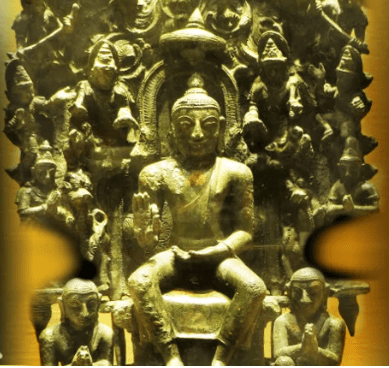UPSC Exam > UPSC Notes > History Optional for UPSC > Buddhist Centres
Buddhist Centres | History Optional for UPSC PDF Download
| Table of contents |

|
| Historical Significance of Nāgappaṭṭinam |

|
| Buddhist Monuments and Centers |

|
| Buddhist Influence and Notable Figures |

|
| Buddhist Literature and Kanchipuram |

|
Historical Significance of Nāgappaṭṭinam
Ancient Records and Inscriptions:
- The town of Nāgappaṭṭinam has a rich heritage, as evidenced by a Burmese historical text from the 3rd century BCE, which mentions a Budha Vihar built by King Ashoka.
- An inscription from Anuradhapura, Sri Lanka, dated to the 2nd century BCE, highlights the association of Tamil merchants with a Buddhist institution.

Buddhist Monuments and Centers
- Ancient ruins from the 4th-5th centuries, including a Buddhist monastery, a statue of Buddha, and a Buddhapada (footprint of Buddha), were discovered in what is now Pallavanesvaram, a part of the ancient city.
- Nāgappaṭṭinam served as a significant Buddhist center during the 4th-5th centuries CE, with a stupa dating back to this period.
Decline and Revival of Buddhism:
- Buddhism gradually declined in Nāgappaṭṭinam, but it witnessed a revival in the 9th century.
- In the 11th century, the Chudamani Vihara was constructed by the Javanese king Sri Vijaya Soolamanivarman, with support from Raja Raja Chola I.
Renovation and Recognition:
- The “Animangalam Copperplate” of Kulothungachola mentions the renovation of a Buddhist temple by “Kasiba Thera” in the 6th century, with assistance from Buddhist monks of “Naga Nadu.” This temple later became known as “Nagananavigar.”
Pallava and Chola Periods:
- Buddhism thrived in Tamil Nadu during two main phases: the early Pallava rule (400-650 AD) and the Chola period (mid 9th to early 14th century AD).
- Prominent Buddhist centers during this time included Kanchipuram, Kaveripattinam, Uraiyur, and Nagapattinam.
Hsuan Tsang's Accounts:
- The Chinese Buddhist monk Hsuan Tsang, who visited India in the 7th century AD, described Kanchipuram as a prosperous city with a predominantly Buddhist population.
- He noted the presence of over 100 Buddhist monasteries and more than a thousand Buddhist monks, including 300 monks from Sri Lanka in one monastery.
Question for Buddhist CentresTry yourself: Which Chinese Buddhist monk visited India in the 7th century and described Kanchipuram as a prosperous city with a predominantly Buddhist population?View Solution
Buddhist Influence and Notable Figures
- Pallava king Mahendra Varman, in his Sanskrit work “Mattavilasa Prahasana,” acknowledged the existence of numerous Buddhist Viharas, with the Raja Vihare being the most prominent.
- Notable Buddhist scholars associated with Kanchipuram included Rev. Dharmapala, the rector of Nalanda University, and Anuruddha Thera, the author of the Abhidammathasangaha.
- Although it is unclear whether Ven. Buddhaghosha was a native of Kanchipuram, he spent time in the city during the 7th century and praised its people for their bravery, piety, love of justice, and veneration for learning.

Pallava Dynasty Influence:
- Kanchipuram gained prominence during the Pallava dynasty from the 4th to the 9th centuries, serving as the Pallava capital.
- Many well-known temples in the city were constructed during this period, and according to Tamil tradition, Bodhidharma, the founder of Zen Buddhism, was born here.
Buddhist Literature and Kanchipuram
- “Manimekalai,” a post-Sangam epic, is considered a significant work of Buddhist literature.
- The classical epic provides an intricate description of Kanchipuram, highlighting its importance in Buddhist history and culture.
The document Buddhist Centres | History Optional for UPSC is a part of the UPSC Course History Optional for UPSC.
All you need of UPSC at this link: UPSC
|
367 videos|995 docs
|
FAQs on Buddhist Centres - History Optional for UPSC
| 1. Nāgappaṭṭinam के ऐतिहासिक महत्व क्या हैं? |  |
Ans. Nāgappaṭṭinam, प्राचीन तमिलनाडु का एक महत्वपूर्ण बंदरगाह शहर था, जो व्यापारिक गतिविधियों और सांस्कृतिक आदान-प्रदान का केंद्र था। यह शहर बौद्ध धर्म के प्रसार में भी महत्वपूर्ण भूमिका निभाता था, जहाँ बौद्ध मठ और स्तूप निर्मित किए गए थे। इसके अलावा, यह शहर चोल साम्राज्य के तहत एक महत्वपूर्ण व्यापारिक केंद्र भी रहा है।
| 2. बौद्ध स्मारकों और केंद्रों का महत्व क्या है? |  |
Ans. बौद्ध स्मारक और केंद्र, जैसे कि स्तूप और मठ, बौद्ध धर्म के अध्ययन और प्रचार का स्थल होते थे। ये स्थल न केवल धार्मिक गतिविधियों के लिए बल्कि सामाजिक और सांस्कृतिक मेलजोल के लिए भी महत्वपूर्ण थे। ये स्मारक बौद्ध कला और वास्तुकला के अद्वितीय उदाहरण प्रस्तुत करते हैं, जो उस समय की धार्मिक और सांस्कृतिक धारा को दर्शाते हैं।
| 3. भारतीय बौद्ध धर्म पर कौन से प्रमुख व्यक्तित्वों का प्रभाव पड़ा? |  |
Ans. भारतीय बौद्ध धर्म पर कई प्रमुख व्यक्तित्वों का प्रभाव पड़ा, जिनमें गौतम बुद्ध, आचार्य नागार्जुन, और बोधिसत्त्व अवलोकितेश्वर शामिल हैं। गौतम बुद्ध ने बौद्ध धर्म की नींव रखी, जबकि नागार्जुन ने महायान बौद्ध धर्म के सिद्धांतों को विकसित किया। इन व्यक्तियों के विचार और शिक्षाएँ बौद्ध धर्म के विकास में अत्यंत महत्वपूर्ण रही हैं।
| 4. कांचीपुरम में बौद्ध साहित्य का क्या योगदान है? |  |
Ans. कांचीपुरम, जिसे पहले कांची के नाम से जाना जाता था, बौद्ध साहित्य का एक महत्वपूर्ण केंद्र रहा है। यहाँ पर कई प्रसिद्ध बौद्ध विद्वानों ने अपने ग्रंथों की रचना की। बौद्ध साहित्य में तात्त्विक, नैतिक और दर्शन संबंधी विषयों पर गहन विचार-विमर्श किया गया, जिसने बौद्ध धर्म के विचारों को और विस्तारित किया।
| 5. बौद्ध केंद्रों का विकास कैसे हुआ? |  |
Ans. बौद्ध केंद्रों का विकास विभिन्न समय अवधियों में हुआ, जब बौद्ध धर्म भारतीय उपमहाद्वीप में फैलने लगा। मुख्य रूप से, शासकों के संरक्षण, व्यापारिक संबंधों के माध्यम से सांस्कृतिक आदान-प्रदान और समाज में बौद्ध शिक्षाओं की बढ़ती मांग ने इन केंद्रों के विकास में योगदान दिया। प्रमुख बौद्ध केंद्रों में नालंदा, तक्षशिला और सारनाथ शामिल हैं, जो शिक्षा और ज्ञान के केंद्र बने।
Related Searches














